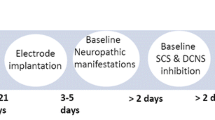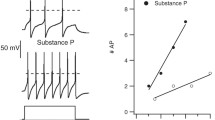Summary
The effect of apomorphine on bilateral dorsal root potentials (DRPs) spreading caudally and cranially along three segments of the lower spinal cord was studied in spinal cats anaesthetized with thiamylal sodium. The DRPs were produced by single impulses at 4 times the threshold strength. Apomorphine in a dose of 5 mg/kg, i.v., depressed ipsilateral DRPs spreading caudally to 77% of their initial amplitude and the period of depression was 50 min. Depression of DRPs spreading cranially was significantly greater (maximum reduction to 59%) and lasted about 60 min. Contralateral DRPs spreading cranially were also more depressed than those spreading caudally. These effects were not due to differences in the level of the spinal cord segments investigated. Increase in strength of stimulation to 40 times threshold did not significantly change the depression of DRPs produced by apomorphine. Depression of DRPs depended on the dose of apomorphine. Pimozide and haloperidol blocked the apomorphine-induced depression of the DRPs. It is suggested that differences in the depression of the DRPs spreading caudally and cranially result from different numbers of dopaminergic neurons terminating on interneurons transmitting depolarization cranially or caudally, respectively.
Similar content being viewed by others
References
Andén, N. E., Rubenson, A., Fuxe, K., Hokfelt, T.: Evidence for dopamine receptor stimulation by apomorphine. J. Pharm. Pharmacol. 19, 626–629 (1967)
Andén, N. E., Butcher, S. G., Corrodi, H., Fuxe, K., Ungerstedt, U.: Receptor activity and turnover of dopamine and noradrenaline after neuroleptics. Eur. J. Pharmacol. 11, 303–314 (1970)
Andén, N. E., Bédard, P., Fuxe, K., Ungerstedt, U.: Early and selective increase in brain dopamine after axotomy. Experientia (Basel) 28, 300–301 (1972)
Barron, D. H., Matthews, B. H. C.: The interpretation of potential changes in the spinal cord. J. Physiol. (Lond.) 92, 276–321 (1938)
Bingham, W. G., Ruffolo, R., Goodman, J. H., Knofel, J., Friedman, S.: Norepinephrine and dopamine levels in normal dog and monkey spinal cord. Life Sci. 16, 1521–1526 (1975)
Casey, K. L., Oakley, B.: Intraspinal latency, cutaneous fiber composition, and afferent control of the dorsal root reflex in cat. Brain Res. 47, 353–369 (1972)
Commissiong, J. W., Galli, C. L., Neff, N. H.: Differentiation of dopaminergic and noradrenergic neurons in rat spinal cord. J. Neurochem. 30, 1095–1099 (1978)
Devor, M., Merrill, E. G., Wall, P. D.: Dorsal horn cells that respond to stimulation of distant dorsal roots. J. Physiol. (Lond.) 270, 519–531 (1977)
Ernst, A. M.: Mode of action of apomorphine and dexamphetamine on gnawing compulsion in rats. Psychopharmacologia (Berl.) 10, 316–323 (1967)
Kebabian, J. W., Petzold, G. L., Greengard, P.: Dopamine-sensitive adenylate cyclase in caudate nucleus of rat brain, and its similarity to the “dopamine receptor”. Proc. Natl. Acad. Sci. USA 69, 2145–2149 (1972)
Lupa, K., Niechaj, A.: Bilateral dorsal root potentials in the lower sacral spinal cord. Pflügers Arch. 369, 187–192 (1977)
Lupa, K., Wójcik, G., Ożóg, M., Niechaj, A.: Spread of the dorsal root potentials in lower lumbar, sacral and upper caudal spinal cord. Pflügers Arch. 381, 201–207 (1979)
Magnusson, T.: Effect of chronic transection on dopamine, noradrenaline and 5-hydroxytryptamine in the rat spinal cord. Naunyn-Schmiedeberg's Arch. Pharmacol. 278, 13–22 (1973)
Nygren, L. G., Olson, L.: On spinal noradrenaline receptor supersensitivity: correlation between nerve terminal densities and flexor reflexes various times after intracisternal 6-hydroxydopamine. Brain Res. 116, 455–470 (1976)
Reid, J. L., Zivin, J. A., Foppen, F. H., Kopin, I. J.: Catecholamine neurotransmitters and synthetic enzymes in the spinal cord of the rat. Life Sci. 16, 975–984 (1975)
Roos, B. E.: Decrease in homovanillic acid as evidence for dopamine receptor stimulation in the neostriatum of the rat. J. Pharm. Pharmacol. 21, 263–264 (1969)
Schlosser, W., Horst, W. D., Spiegel, H. E., Sigg, W. B.: Apomorphine and its effects on the spinal cord. Neuropharmacology 11, 417–426 (1972)
Szentágothai, J.: Neuronal and synaptic arrangement in the substantia gelatinosa Rolandi. J. Comp. Neurol. 122, 219–239 (1964)
Wall, P. D.: The origin of a spinal cord slow potential. J. Physiol. (Lond.) 164, 508–526 (1962)
Author information
Authors and Affiliations
Rights and permissions
About this article
Cite this article
Lupa, K., Wójcik, G. & Niechaj, A. Differential depression by apomorphine of the dorsal root potentials spreading caudally and cranially in the cat spinal cord. Naunyn-Schmiedeberg's Arch. Pharmacol. 310, 21–24 (1979). https://doi.org/10.1007/BF00499870
Received:
Accepted:
Issue Date:
DOI: https://doi.org/10.1007/BF00499870




